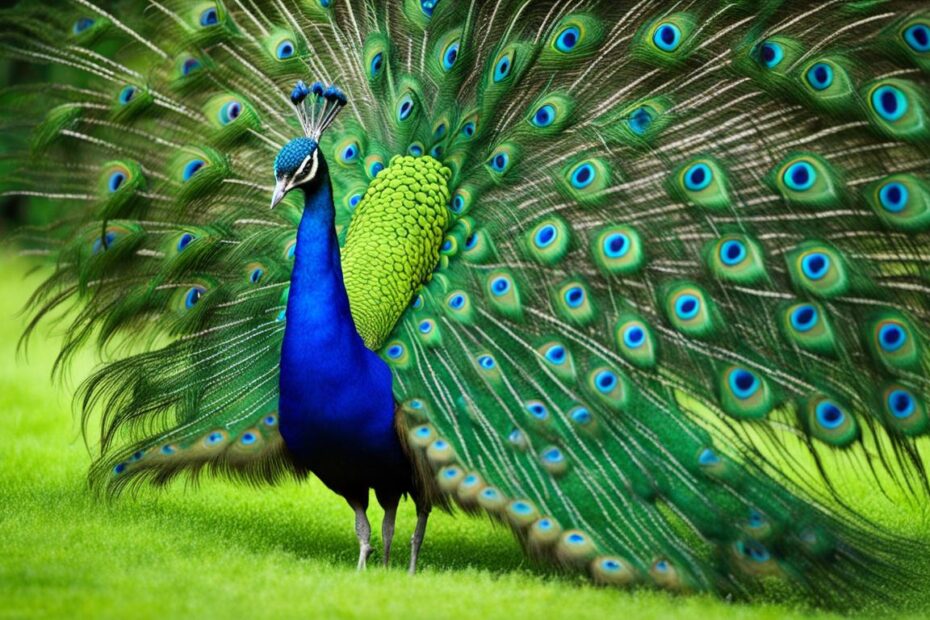Peacocks, with their vibrant plumage and captivating courtship displays, have always fascinated nature enthusiasts. If you’ve ever wondered about the frequency of peacock mating, you’re in the right place. In this article, we will explore the intriguing mating behavior of peacocks, shedding light on how often they mate and the factors that influence their reproductive patterns.
Peacocks have a breeding season that typically ranges from February to May in India and December to May in Sri Lanka. Green peafowls in North India breed from January to May and from July to September. The mating season may vary depending on the geographic location and closely relates to the monsoons. During this time, male peacocks display their colorful plumage and perform elaborate courtship dances to attract females. They tend to maintain a harem of 3-5 females during the mating season.
Key Takeaways:
- Peacocks have a breeding season that varies depending on the geographic location and is closely related to the monsoons.
- Male peacocks display their colorful plumage and perform courtship dances during the mating season.
- Peacocks often maintain a harem of 3-5 females during the breeding season.
Understanding Peacock Mating Systems
Peacocks have a fascinating mating system that involves both polygamous and monogamous behavior. Male peacocks often gather a harem of females and compete with other males to win their favor. This polygamous behavior is commonly observed in the wild, where males strive to attract multiple females during the mating season. However, in captive breeding centers or zoos, some populations of peafowl have been observed to form monogamous pair bonds.
In their natural habitat, peacocks engage in elaborate courtship displays to attract females. The male peacock’s colorful plumage and extravagant tail feathers play a crucial role in this process. Through their dance-like courtship rituals and vibrant displays, male peacocks aim to impress and secure a mate. The courtship dance, also known as “train-rattling,” involves spreading the tail feathers to reveal mesmerizing patterns and colors. This display is accompanied by loud calls that announce the male’s presence to other males and attract females.
Female peacocks, known as peahens, play an active role in mate selection. They choose their mates based on various factors, including the male’s physical appearance, courtship behavior, and genetic fitness. The male’s colorful plumage, long train feathers, and intricate dance movements are all signals of his quality as a potential mate. Peahens are more likely to select males with vibrant and well-maintained plumage, as it indicates good health and genetic superiority.
| Peacock Mating Systems | Summary |
|---|---|
| Polygamous Mating | – Males form harems of females and compete for access to mates. – Common in the wild. – Multiple mating partners. |
| Monogamous Mating | – Some populations form pair bonds. – More commonly observed in captive breeding centers or zoos. – One male mates with one female. |
The complex mating behaviors of peacocks reflect the interplay between male displays and female choice. These interactions have contributed to the evolution of the peacock’s extravagant plumage, as females prefer males with larger, more vibrant tail feathers. Through their mating systems and courtship rituals, peacocks showcase the dynamic and captivating nature of reproduction in the animal kingdom.
The Fascinating Courtship Rituals of Peacocks
Peacocks engage in elaborate courtship rituals to attract females. The male peacock will display his colorful plumage and perform a dance, spreading his tail feathers to reveal vibrant colors and patterns. This courtship display, known as “train-rattling,” is meant to impress and attract potential mates. During this time, the male will also make loud calls to announce his presence to other males and attract females.
These courtship rituals are a spectacle to behold, captivating both the eyes and ears. The male peacock’s vibrant feathers serve as a visual signal of his genetic fitness, indicating health and vitality. The intricate patterns and striking colors showcase the male’s ability to attract and protect a mate.
But it’s not just the visual display that captivates the females. The male peacock’s dance and calls create an auditory experience that adds to the allure. The rhythmic movements, spinning, and shaking of feathers create a rattling sound that resonates in the surrounding environment. It’s a symphony of movement and sound that signifies the male’s strength and prowess.
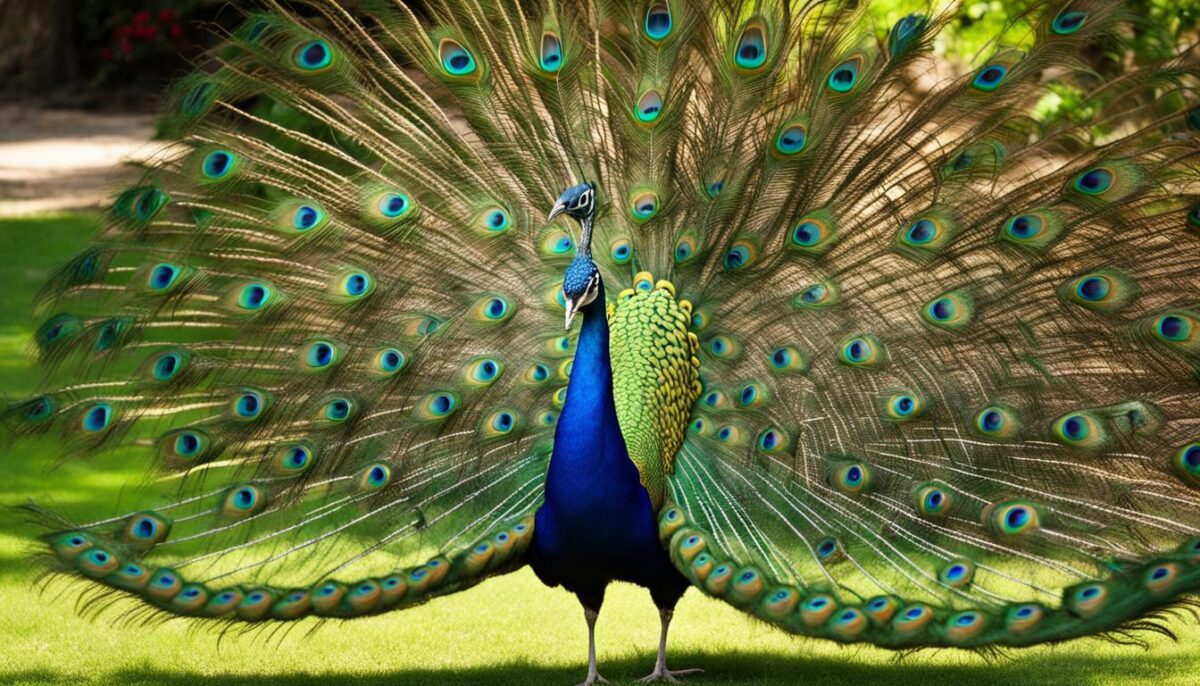
The Courtship Dance of Peacocks
The courtship dance of male peacocks is an intricate and mesmerizing display. The male spreads his tail feathers, revealing the vibrant colors and intricate patterns. He will then perform a series of movements, including spinning in circles and shaking his feathers, which creates a rattling sound. This dance is meant to attract the attention of females and demonstrate the male’s physical fitness and genetic quality.
| Aspect of Courtship Dance | Description |
|---|---|
| Feather Display | The male spreads his tail feathers to reveal their vibrant colors and patterns, showcasing his genetic fitness. |
| Movements | The male performs intricate movements, such as spinning in circles and shaking his feathers, creating a visually captivating display. |
| Rattling Sound | The shaking of feathers produces a distinctive rattling sound that adds to the auditory appeal of the courtship dance. |
“The courtship dance of peacocks is a magnificent spectacle that showcases the male’s beauty, strength, and genetic quality. It’s a visual and auditory display that mesmerizes both the females and onlookers.”
Factors in Peacock Mate Selection
Peacock mating behavior is influenced by various factors that play a role in mate selection. Female peacocks, known as peahens, have specific criteria when choosing their mates. These criteria include physical appearance, courtship behavior, and the male’s ability to provide resources and protect the female and her offspring.
One of the key factors in mate selection is the male’s physical appearance, particularly his colorful plumage and the length of his train feathers. The vibrant colors and intricate patterns of a male peacock’s feathers serve as visual signals of his genetic fitness and quality. Females may be more attracted to males with longer and more colorful feathers, as these traits indicate a higher reproductive potential.
Another important factor is the male’s courtship behavior. Peacocks engage in elaborate courtship displays, such as spreading their tail feathers and performing a dance known as “train-rattling.” The quality of the male’s dance and the intensity of his calls can influence whether a female is attracted to him. These courtship rituals serve as signals of the male’s physical fitness and genetic quality, further influencing mate selection.
Aside from physical appearance and courtship behavior, females also consider the male’s ability to provide resources and protect them. Males that demonstrate their ability to find food and defend their territory are more likely to be chosen as mates. This ensures that the female and her offspring will have access to resources and be well-protected.
Table: Factors in Peacock Mate Selection
| Factors | Description |
|---|---|
| Physical Appearance | Male peacock’s colorful plumage and length of train feathers |
| Courtship Behavior | Elaborate displays and quality of dance |
| Resource Provision | Male’s ability to provide food and protect the female and her offspring |
The Evolutionary Significance of Peacock Plumage
The beautiful plumage of peacocks, specifically their elaborate tails, is believed to have evolved through a process called sexual selection. This means that peahens have selected males with the most attractive plumage over time, leading to the development of the extravagant tails. Males with longer and more colorful tails are often more successful in attracting mates and passing on their genes. The length and quality of the train feathers are indicators of a male’s genetic fitness and reproductive success.
Peacocks invest a significant amount of energy in growing and maintaining their elaborate tails, which can reach up to five feet in length. This extravagant display requires a high level of physical fitness and good health, making the tails an honest signal of a male’s genetic quality. The vibrant colors and patterns of the feathers are thought to be indicators of the male’s ability to withstand parasites and diseases, as well as his overall fitness.
Peacocks have evolved to have such stunning plumage because it gives them an advantage in attracting mates. The more attractive and healthy a male appears, the more likely he is to be chosen by a female for mating. Evolution has favored males with elaborate tails, resulting in the breathtaking plumage we see today.
The Role of Peacock Plumage in Mating
The extravagant plumage of peacocks plays a crucial role in attracting mates. When a male is ready to mate, he will spread his tail feathers in a display known as “train-rattling.” This elaborate courtship ritual showcases the vibrant colors and intricate patterns of his feathers, which are designed to capture the attention of nearby females. The male will also perform a dance, shaking his feathers and creating a rattling sound that further enhances his display.
Peahens are highly selective when choosing a mate, and they are particularly drawn to males with larger and more elaborate tails. The length and quality of a male’s train feathers are indicators of his genetic fitness and reproductive success. By choosing males with impressive plumage, peahens increase the likelihood of producing offspring with similar attractive traits.
- The vibrant colors and patterns of peacock plumage are indicators of a male’s genetic fitness.
- Males with longer and more elaborate tails are more successful in attracting mates.
- The extravagant plumage requires a high level of physical fitness and good health.
- Peahens are selective in choosing mates and are drawn to males with larger and more elaborate tails.
- By choosing males with attractive plumage, peahens increase the likelihood of producing offspring with similar traits.
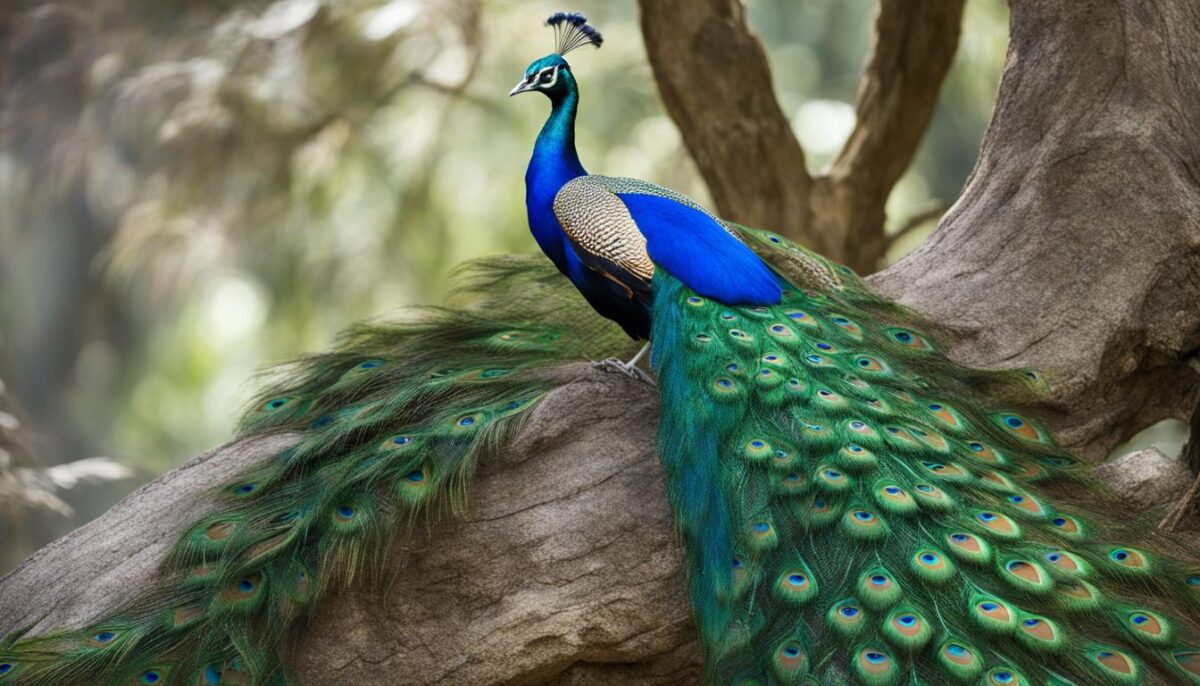
| Advantages of Peacock Plumage | Disadvantages of Peacock Plumage |
|---|---|
| Attracts mates | Increased vulnerability to predators |
| Indicates genetic fitness | Requires high energy expenditure |
| Enhances reproductive success | May hinder maneuverability in flight |
| Signals good health and resistance to parasites | Can become damaged or tangled |
Peacock Mating and Breeding Season Variations
Peacocks, with their vibrant plumage and elaborate courtship rituals, have a fascinating mating behavior that varies across different geographic locations. The breeding season of peacocks generally starts from February to May in India and December to May in Sri Lanka. In North India, the mating season extends from January to May and from July to September, aligning with the monsoon seasons in these regions. These variations in the breeding season can be attributed to factors such as habitat, food availability, and social behavior.
The timing and duration of the mating season are closely linked to environmental cues. Peacocks rely on monsoons for food availability, as it brings an abundance of insects and plant materials, essential for their survival and reproduction. The lush vegetation during the monsoon season also provides suitable nesting sites and hiding places for the females and their offspring. Therefore, the mating season of peacocks is synchronized with the availability of resources during the monsoon period.
Peacocks exhibit fascinating courtship behaviors during their mating season. The male peacock displays his extravagant plumage, spreading his tail feathers in a magnificent fan-like display. This visually striking courtship dance, accompanied by loud calls, is meant to attract the attention of females and signal the male’s fitness as a potential mate. The females, known as peahens, observe these displays and choose their mates based on physical appearance, courtship behavior, and genetic fitness.
| Geographic Location | Mating Season |
|---|---|
| India | February to May |
| Sri Lanka | December to May |
| North India | January to May and July to September |
The breeding season variations in peacocks highlight the biological adaptation of these magnificent birds to their respective environments. By aligning their mating behaviors with the availability of resources, peacocks maximize their chances of reproductive success and ensure the survival of their offspring.
The Courtship Dance of Peacocks
The courtship dance of male peacocks is a mesmerizing display that showcases their vibrant plumage and physical prowess. During this ritual, the male spreads his magnificent tail feathers, revealing a stunning array of colors and intricate patterns. The dance involves a series of movements, including spinning in circles and shaking the feathers, which creates a mesmerizing rattling sound that adds to the captivating spectacle.
This courtship dance serves a vital purpose in attracting the attention of female peacocks. It is a visual and auditory display designed to impress and entice potential mates. The male’s colorful plumage and elaborate dance moves communicate his genetic fitness and overall health, making him a desirable partner for reproduction.
The courtship dance of peacocks is not only a display of physical prowess but also a reflection of their evolutionary success. The elaborate plumage and dance routine have evolved over time through sexual selection, with peahens preferring males with longer and more vibrant tails. These traits are seen as indicators of the male’s genetic fitness and reproductive potential, as well as his ability to provide for and protect his offspring.
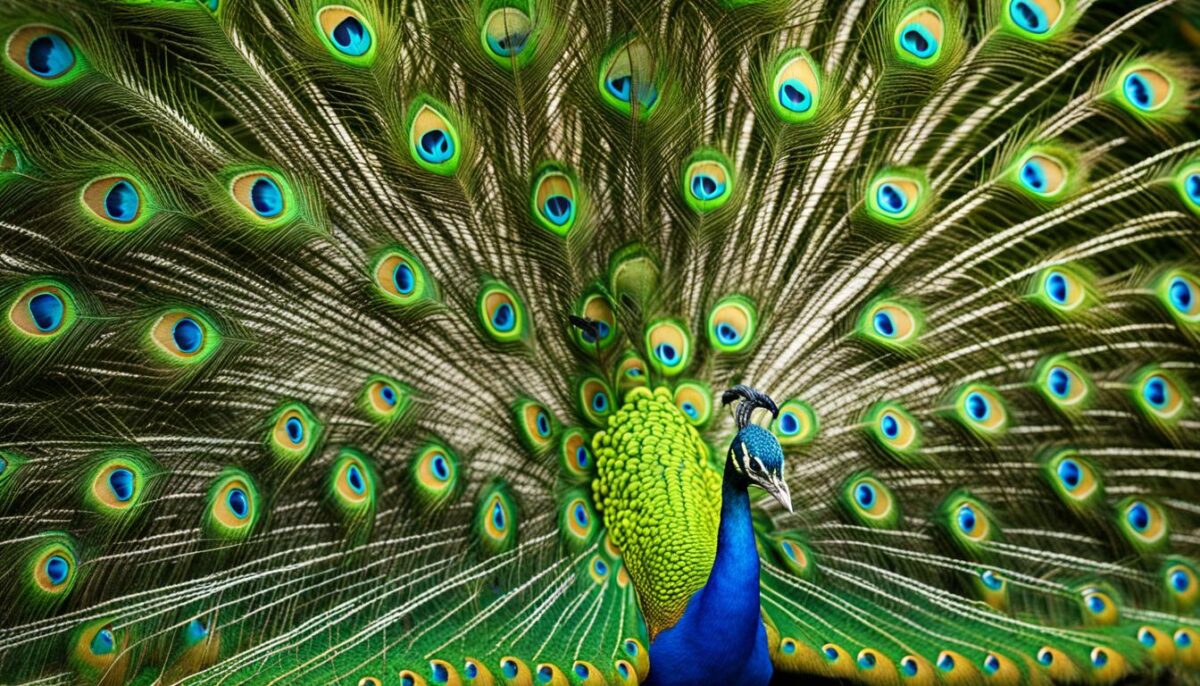
The combination of visual and auditory displays in peacock mating rituals creates a captivating spectacle that entices and mesmerizes potential mates. The male peacock’s stunning plumage, accompanied by its elaborate courtship dance and distinctive calls, is a powerful and persuasive display of genetic superiority. Peahens carefully observe and evaluate these displays, ultimately choosing a mate that best meets their preferences and maximizes their chances of reproductive success.
| Mating Display | Description |
|---|---|
| Colorful Plumage | The male displays vibrant, iridescent feathers in a variety of colors, including blues, greens, and browns. |
| Train Rattling | The male spreads his tail feathers, creating a fan-like display. He then shakes his feathers, producing a distinct rattling sound. |
| Courtship Dance | The male performs a series of movements, including spinning in circles and bowing, to showcase his physical fitness and genetic quality. |
| Loud Calls | The male emits loud, distinctive calls that attract females and assert dominance over other males in the vicinity. |
The Polygamous Nature of Peacock Mating
Peacocks are known for their stunning plumage and elaborate courtship displays. But what is the nature of their mating behavior? Well, peacocks are polygamous creatures, meaning they mate with multiple partners. Males often form harems of females and compete with other males for access to these females. This polygamous mating system ensures that peacocks have the best chance of passing on their genes and ensuring the survival of their species.
Research has shown that the number of eyespots on a male peacock’s train feathers correlates with mating success. Peahens, the female peacocks, may prefer males with a larger number of eyespots as it indicates genetic fitness and quality. These eyespots are fascinating visual signals that have evolved over time through a process of sexual selection. Peahens choose mates based on these signals, ensuring that they select the most attractive and genetically fit males.
To understand the importance of polygamous mating in peacocks, it’s essential to consider the evolutionary significance of their stunning plumage. The extravagant tails and vibrant colors of peacocks have evolved through sexual selection. Males with longer and more colorful tails are often more successful in attracting mates, and their genes are more likely to be passed on to the next generation. These visual displays play a vital role in the reproductive patterns of peacocks and contribute to their overall mating frequency.
| Characteristics | Importance |
|---|---|
| Number of eyespots on train feathers | Correlates with mating success and genetic quality |
| Train feather length and colorfulness | Attractiveness to potential mates |
| Male courtship behavior | Influence on mate selection |
Overall, the polygamous nature of peacock mating ensures genetic diversity and the survival of the species. The elaborate courtship rituals and displays of the male peacock play a crucial role in attracting and securing mates. The stunning plumage of peacocks is not only a visual spectacle but also a testament to the fascinating evolutionary processes that shape their mating behavior.
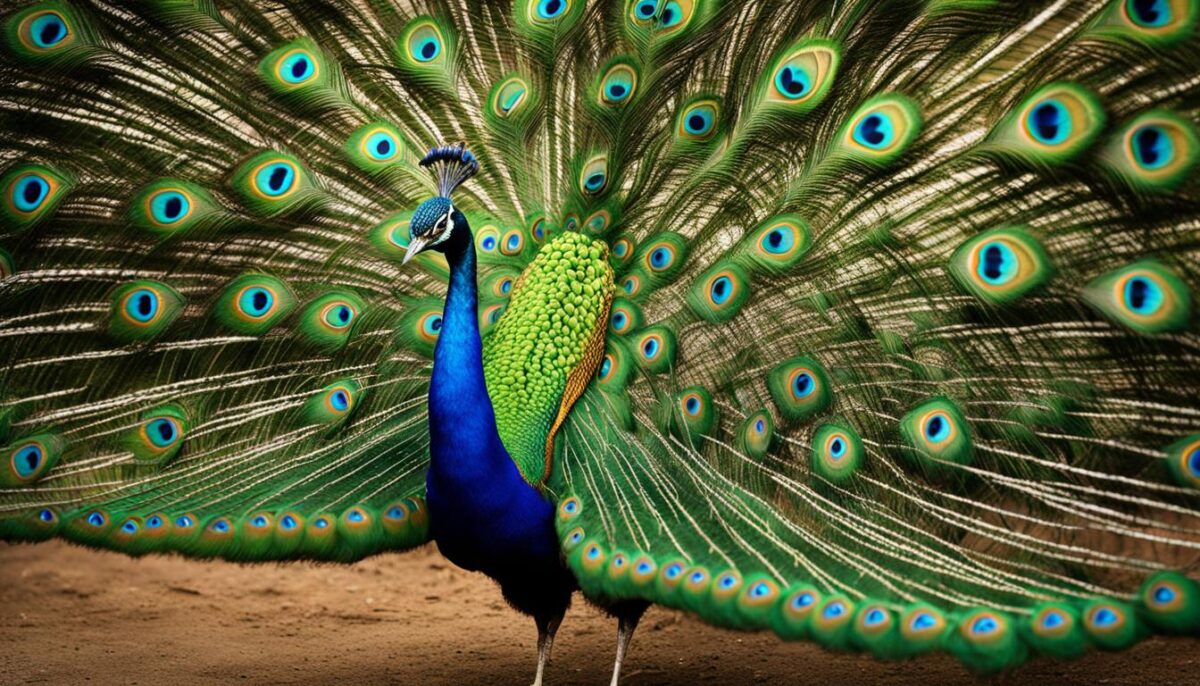
Peacock Mating and Lifelong Bonds
The mating behavior of peacocks is a captivating display of courtship rituals and colorful plumage. While some instances of monogamous pair bonds have been observed in captive breeding centers or zoos, in the wild, peacocks are more likely to engage in polygamous mating. This means that they mate with multiple partners and form harems of females, competing with other males for access to these females.
The elaborate courtship dances and displays performed by male peacocks play a crucial role in attracting and securing mates. These displays include spreading their vibrant, colorful tail feathers and performing mesmerizing dances. The male peacock’s physical fitness and genetic quality are showcased through these courtship behaviors, capturing the attention of females and increasing their chances of successfully attracting a mate.
Peacock mating behavior is driven by the female’s choice based on physical appearance and genetic fitness. Female peacocks, or peahens, choose their mates based on various factors, such as the male’s colorful plumage, the length of his train feathers, and his ability to provide resources and protect her and her offspring. The male’s courtship behavior, including the quality of his dance and the intensity of his calls, also influences mate selection.
Mating Behavior Summary:
- Peacocks engage in polygamous mating, forming harems of females.
- Mating behavior is driven by the male’s courtship displays and the female’s choice based on physical appearance and genetic fitness.
- Male peacocks perform elaborate courtship dances and displays to attract females.
- Female peacocks choose mates based on factors such as colorful plumage, the length of train feathers, and courtship behavior quality.
Peacock Mating and Lifelong Bonds
Peacock mating behavior is characterized by polygamous mating and the formation of harems, with males competing for access to females. While peafowl can form monogamous pair bonds, especially in captive breeding centers or zoos, this behavior is less commonly observed in the wild. The courtship rituals and displays of male peacocks play a vital role in attracting and securing mates, showcasing their physical fitness and genetic quality.
Female peacocks, or peahens, choose their mates based on various factors, including the male’s colorful plumage, the length of his train feathers, and his courtship behavior quality. The male’s elaborate courtship dances and displays, along with his ability to provide resources and protect the female and her offspring, influence mate selection. Overall, peacock mating behavior is a fascinating display of natural selection and the unique traits that have evolved over time.
| Summary of Peacock Mating Behavior | |
|---|---|
| Behavior | Peacocks engage in polygamous mating, forming harems of females |
| Male Courtship | Males perform elaborate courtship dances and displays to attract females |
| Mate Selection Factors | Females choose mates based on physical appearance, genetic fitness, and courtship behavior quality |
Peacock mating behavior is a complex and intriguing phenomenon, showcasing the remarkable courtship rituals and colorful displays of these magnificent birds. Understanding their mating habits and the factors influencing mate selection sheds light on the evolutionary significance of their elaborate plumage and courtship behaviors.
Conclusion
Peacocks are fascinating creatures known for their elaborate courtship rituals and colorful plumage. They engage in polygamous mating, forming harems of females and competing with other males for access to these females. While there may be some instances of monogamous pair bonding, the general mating behavior of peacocks is towards polygamy. The timing and duration of the breeding season can vary depending on geographic location and environmental factors.
Overall, peacock mating behavior is driven by the male’s displays and the female’s choice based on physical appearance and genetic fitness. Female peacocks, or peahens, select mates based on factors such as the male’s colorful plumage, the length of his train feathers, and his courtship behavior. The male peacock, on the other hand, showcases his vibrant feathers and performs intricate dances to attract potential mates.
Peacock breeding habits are influenced by various factors, including the availability of mates and the social dynamics within their population. By understanding the fascinating mating behavior of peacocks, we gain insight into the evolutionary significance of their extravagant plumage and the role it plays in their reproductive success. These magnificent birds continue to captivate us with their stunning displays and remind us of the beauty and complexity of nature.
FAQ
How often do peacocks mate?
Peacocks have a breeding season that typically ranges from February to May in India and December to May in Sri Lanka. Green peafowls in North India breed from January to May and from July to September. The mating season may vary depending on the geographic location and closely relates to the monsoons.
What is the mating system of peacocks?
Peacocks have a polygamous mating system, which means they mate with multiple partners. Male peacocks often gather a harem of females and compete with other males to win these females. However, some populations of peafowl have been observed to form monogamous pair bonds, although these observations are more common in captive breeding centers or zoos. In the wild, peacocks are more likely to engage in polygynous and polyandrous mating.
What are the courtship rituals of peacocks?
Peacocks engage in elaborate courtship rituals to attract females. The male peacock will display his colorful plumage and perform a dance, spreading his tail feathers to reveal vibrant colors and patterns. This courtship display, known as “train-rattling,” is meant to impress and attract potential mates. During this time, the male will also make loud calls to announce his presence to other males and attract females.
How do female peacocks choose their mates?
Female peacocks, peahens, choose their mates based on a variety of factors. These factors can include physical appearance, such as the male’s colorful plumage and the length of his train feathers. Females may also consider the male’s ability to provide resources and protect her and her offspring. The male’s courtship behavior, including the quality of his dance and the intensity of his calls, can also influence mate selection.
Why do peacocks have such elaborate plumage?
The beautiful plumage of peacocks, specifically their elaborate tails, is believed to have evolved through a process called sexual selection. This means that peahens have selected males with the most attractive plumage over time, leading to the development of the extravagant tails. Males with longer and more colorful tails are often more successful in attracting mates and passing on their genes. The length and quality of the train feathers are indicators of a male’s genetic fitness and reproductive success.
Does the breeding season of peacocks vary?
The breeding season of peacocks can vary depending on the geographic location. In India and Sri Lanka, the mating season generally starts from February to May. In North India, the breeding season extends from January to May and from July to September. The timing of the breeding season closely correlates with the monsoon season. Different factors, such as habitat, food availability, and social behavior, can influence the timing and duration of the mating season for peacocks.
What is the courtship dance of male peacocks like?
The courtship dance of male peacocks is an intricate and mesmerizing display. The male spreads his tail feathers, revealing the vibrant colors and intricate patterns. He will then perform a series of movements, including spinning in circles and shaking his feathers, which creates a rattling sound. This dance is meant to attract the attention of females and demonstrate the male’s physical fitness and genetic quality.
What role do visual and auditory displays play in peacock mating?
Peacock mating behavior involves a combination of visual, auditory, and physical displays. The male’s colorful plumage and train feathers serve as visual signals to attract females. The courtship dance and shaking of feathers create visual and auditory displays that capture the attention of females. The male also makes loud, distinctive calls to attract females and announce his presence to other males. These various displays work together to enhance the male’s chances of successfully attracting a mate.
How often do peacocks mate with multiple partners?
Peacocks have a polygamous mating system, meaning they mate with multiple partners. Male peacocks often form harems of females and compete with other males for access to these females. Research has shown that the number of eyespots on a male’s train feathers correlates with mating success. Peahens may prefer males with a larger number of eyespots, as it indicates genetic fitness and quality.
Do peacocks mate for life?
While some observations suggest that peafowl can form monogamous pair bonds, this is more commonly observed in captive breeding centers or zoos. In the wild, peacocks are more likely to engage in polygamous mating and do not mate for life. The availability of mates and other factors can influence the mating behavior of peacocks. However, the elaborate courtship rituals and displays of the male peacock play a crucial role in attracting and securing mates.


